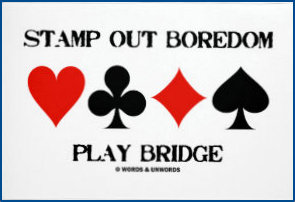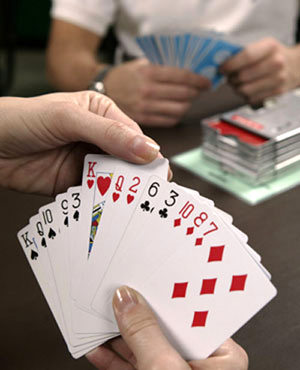 1) Motivate yourself. Discover the many
benefits of learning and playing bridge.
1) Motivate yourself. Discover the many
benefits of learning and playing bridge.
 1) Motivate yourself. Discover the many
benefits of learning and playing bridge.
1) Motivate yourself. Discover the many
benefits of learning and playing bridge.
2) Start with this overview. It explains the object of the game, the "language" of bidding and how a bridge hand is played.
3) Develop your trick-taking skills. Here are the basics of how to set up and win tricks.
Establishing and cashing tricks
4) Plan the play as declarer. Learn how to form a trick-taking plan when you're declaring, then practice playing full deals with the online Minibridge game.
Forming a plan when you're declarer
PRACTICE: Solitaire Minibridge (Select the trump suit, predict how many tricks you'll take and play out the hand. More details are here.)
5) Learn the two most common types of bids. The auction is a conversation where you and partner exchange information about your high cards, suit lengths and playing strength. This often begins with these two bids.
Responses to partner's opening bid
6) Continue the auction. The basic principles here will apply to many other bidding situations.
7) PLAY ! There's more to discover, but if you've come this far, you're ready to have fun playing. In addition to Minibridge (Step 4 above), try these other online solitaire games -- all free -- to practice what you've learned.
Just Play Bridge -- An endless stream of hands where you bid and play against computer robots. As you make bids, the screen will show you the meaning of all the calls made by you and the robots.
Just Declare -- Similar to Minibridge (no bidding), but the contract on each deal is already specified. You try to make the contract by playing the hand against robots.
Bridge Master -- Similar to Just Declare, but each deal includes the solution and instructional tips. Start with the Beginner hands and move up.
8) Discover more ways to evaluate your hand. Improve your bidding accuracy by estimating your hand's "playing strength" along with its high-card points.
Distribution points & hand evaluation
9) Develop your defensive skills. Learn how to build tricks and communicate with partner when you're defending the opponents' contracts.
10) Compete after the opponents open the bidding. On many bridge deals, all four players will be bidding. Here are the two main ways you can enter the auction after your opponent makes the first bid.
11) Learn the system for responding to 1NT. You'll follow a different set of responding guidelines when partner opens 1NT (instead of 1 of a suit).
Responding to a 1NT opening bid
12) Add more opening bids to your system. You can show special types of hands by opening a suit at the 2-level or higher. These bids describe hands with lots of tricks, but fewer high-card points than a 1-level opening.
 Tips
for learners:
Tips
for learners:Take it slow. Few people "get it" the first time a bridge concept is explained. You don't need to master any of the steps above before moving on to the next. Give each one a try and plan to come back later to review.
Print this "cheat sheet". It summarizes basic bidding guidelines and can be a handy reference while you're learning.
Try to avoid memorizing. Focus on the logic behind the rules and how that reasoning can be used to make other decisions in the bidding and play. Your goal is to throw away the "cheat sheet" and rely on your judgment.
Keep playing. Experience is the best teacher, especially for improving card play. Practice with the online solitaire games as often as possible.
Keep learning. These 12 steps cover just the basics, but that's all you need to start enjoying bridge and acquiring more skills. As you become comfortable with what you've learned here, you may want to add to your bidding system and explore other aspects of the game. These sites are excellent resources:
♣ Bridge Basics from Richard Pavlicek -- A concise introduction for the complete beginner.
♣ Karen's Bridge Library -- Bidding summaries, quizzes, reference material and "how-to" tips for beginners and beyond.
♣ American Contract Bridge League (ACBL) Video Library -- Short video lessons on a wide range of topics for beginners and advancing players.
Take the next step. If you can play beginner-level bridge, you can play duplicate bridge. Consider playing in an online club or entering a novice game at your local club. Here are some helpful sites:
♣ Discover the Fun & Challenge of Duplicate Bridge -- An online booklet that explains how a duplicate game works and offers tips for pair and team play.
♣ Find a Club -- Search for a duplicate club near you in this directory from the American Contract Bridge League. Many clubs offer games just for beginners.
♣ Bridgebase Online -- The biggest online playing site, with free games in a variety of formats. The "Relaxed Club" area has tables for newcomers.
© Karen Walker